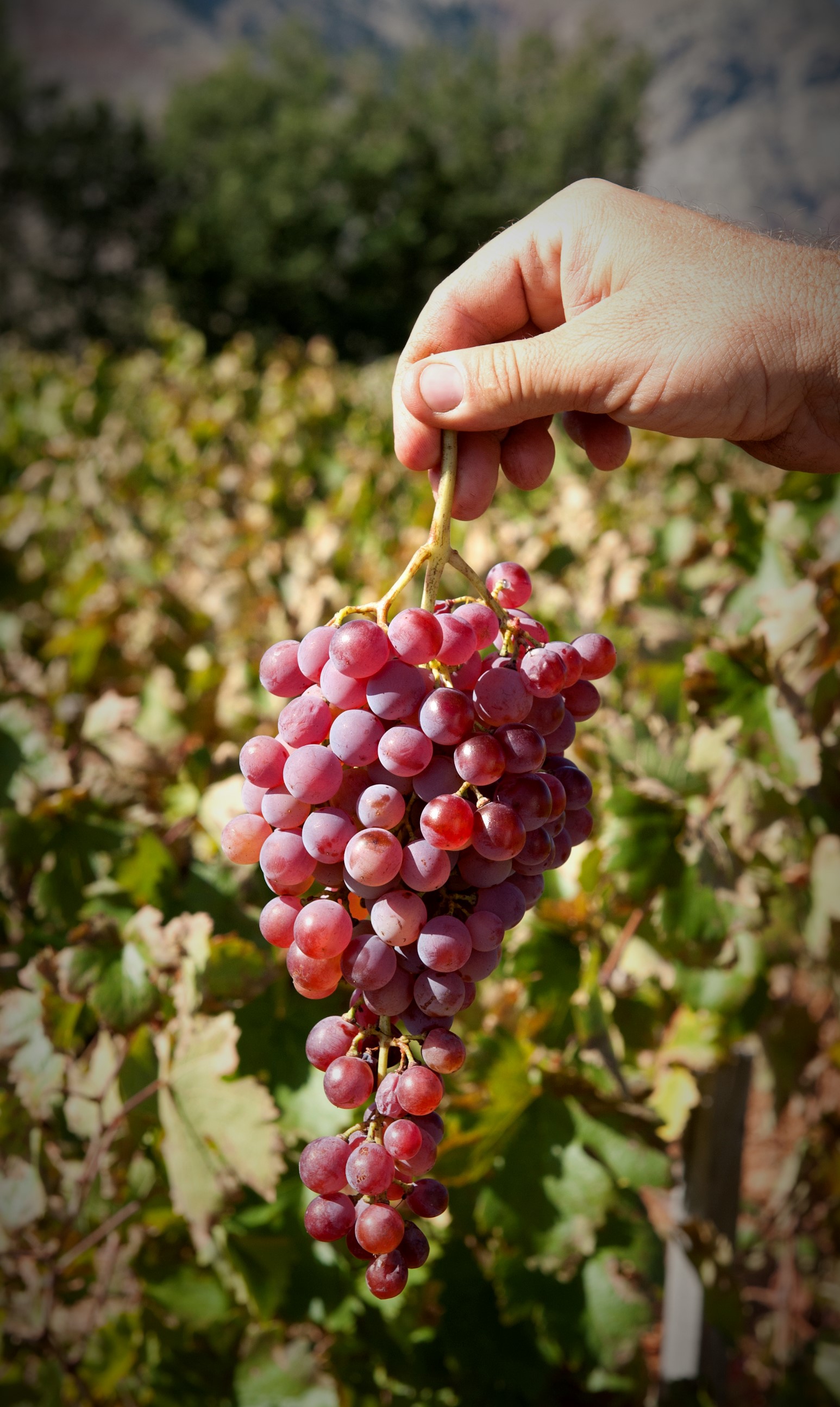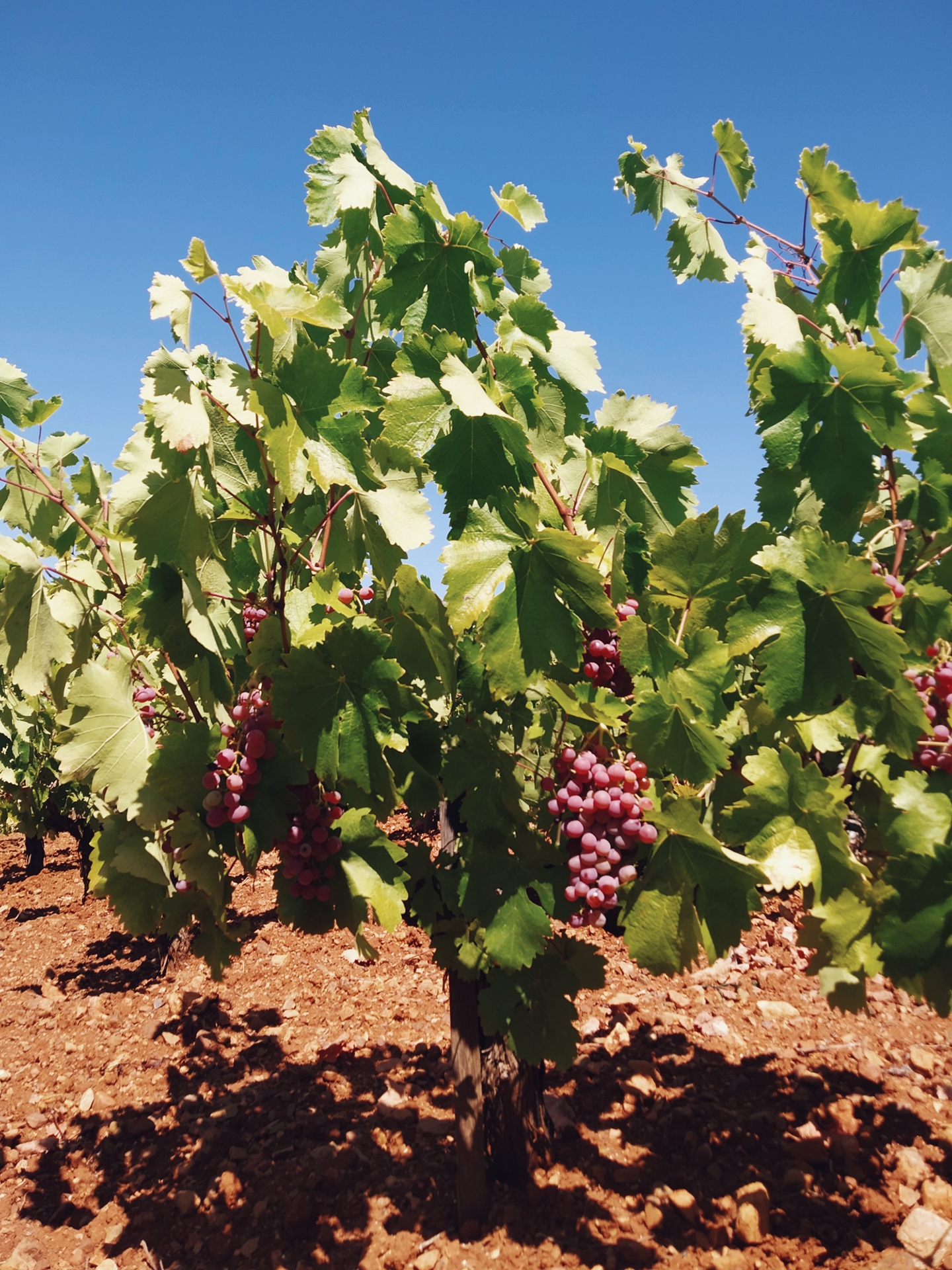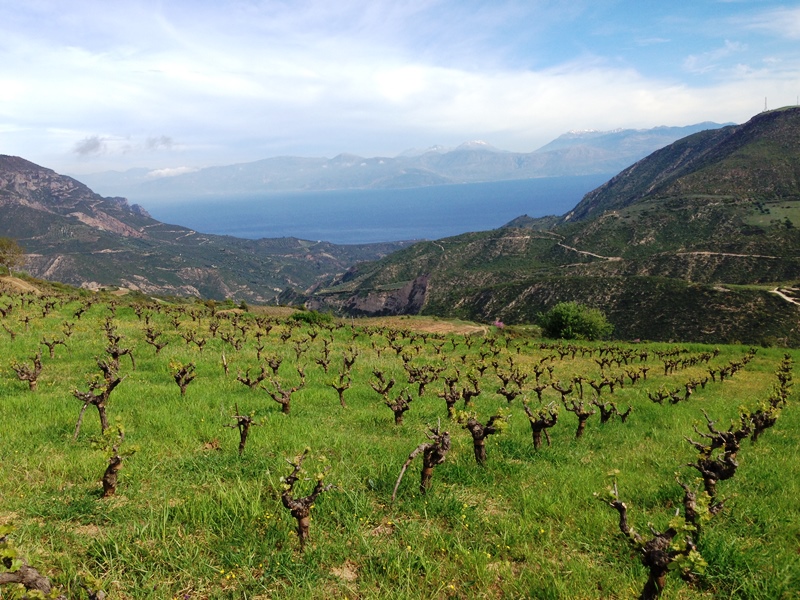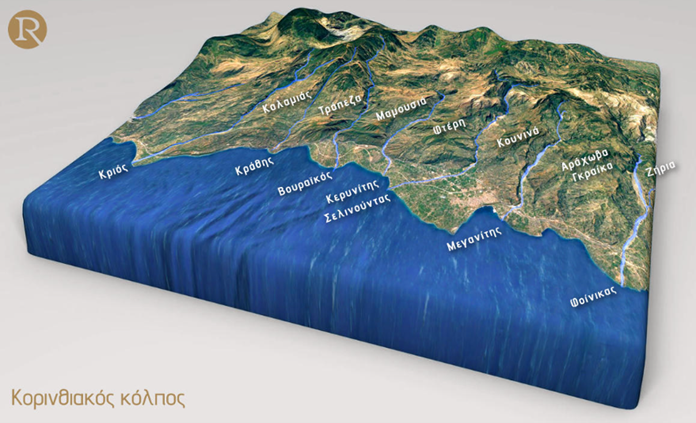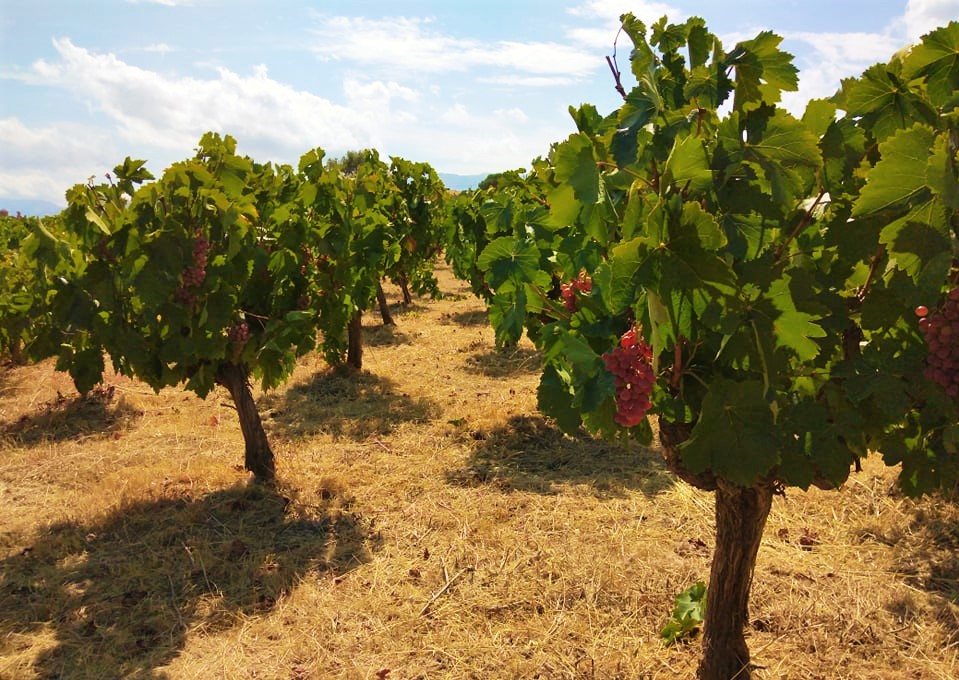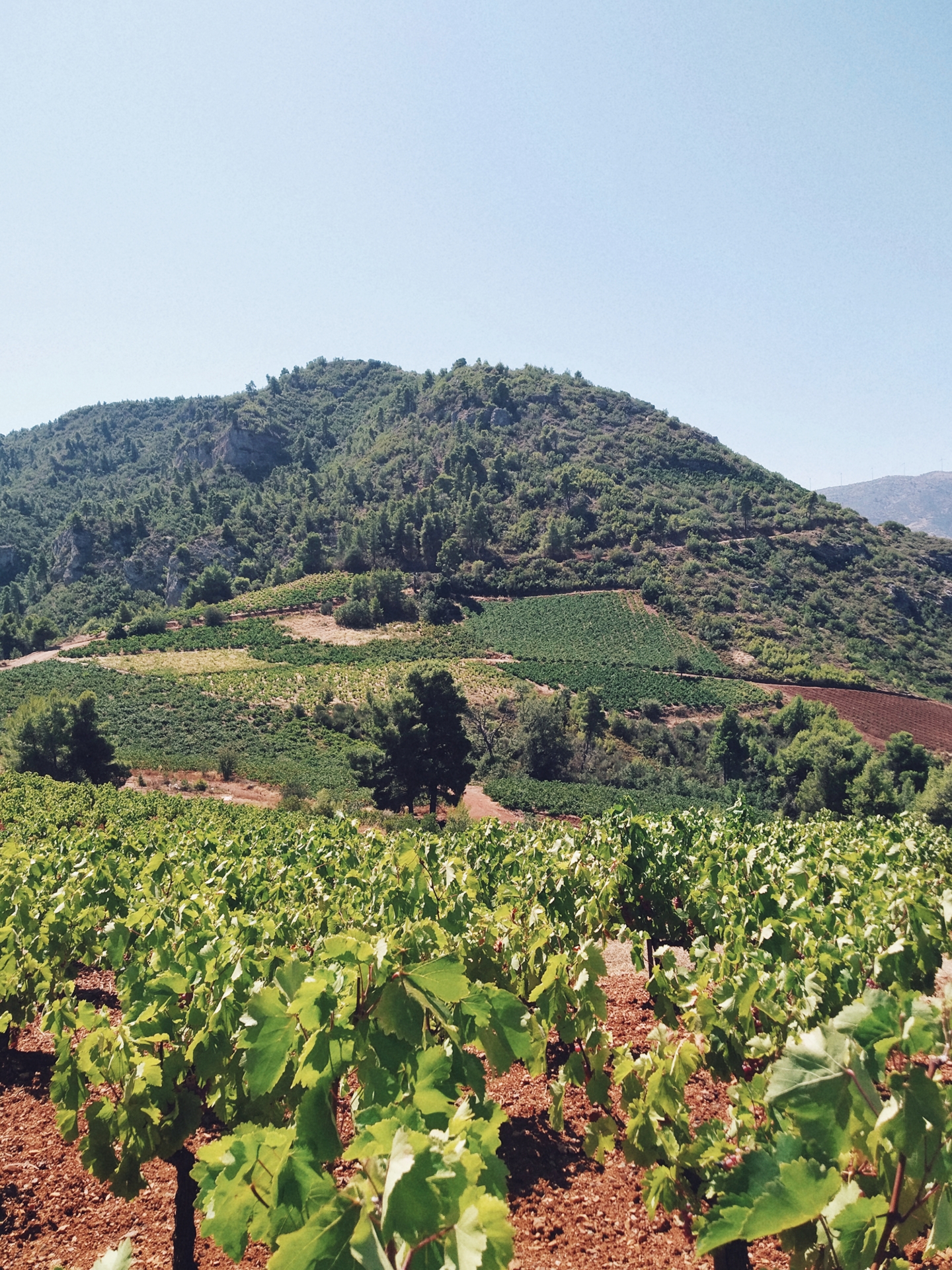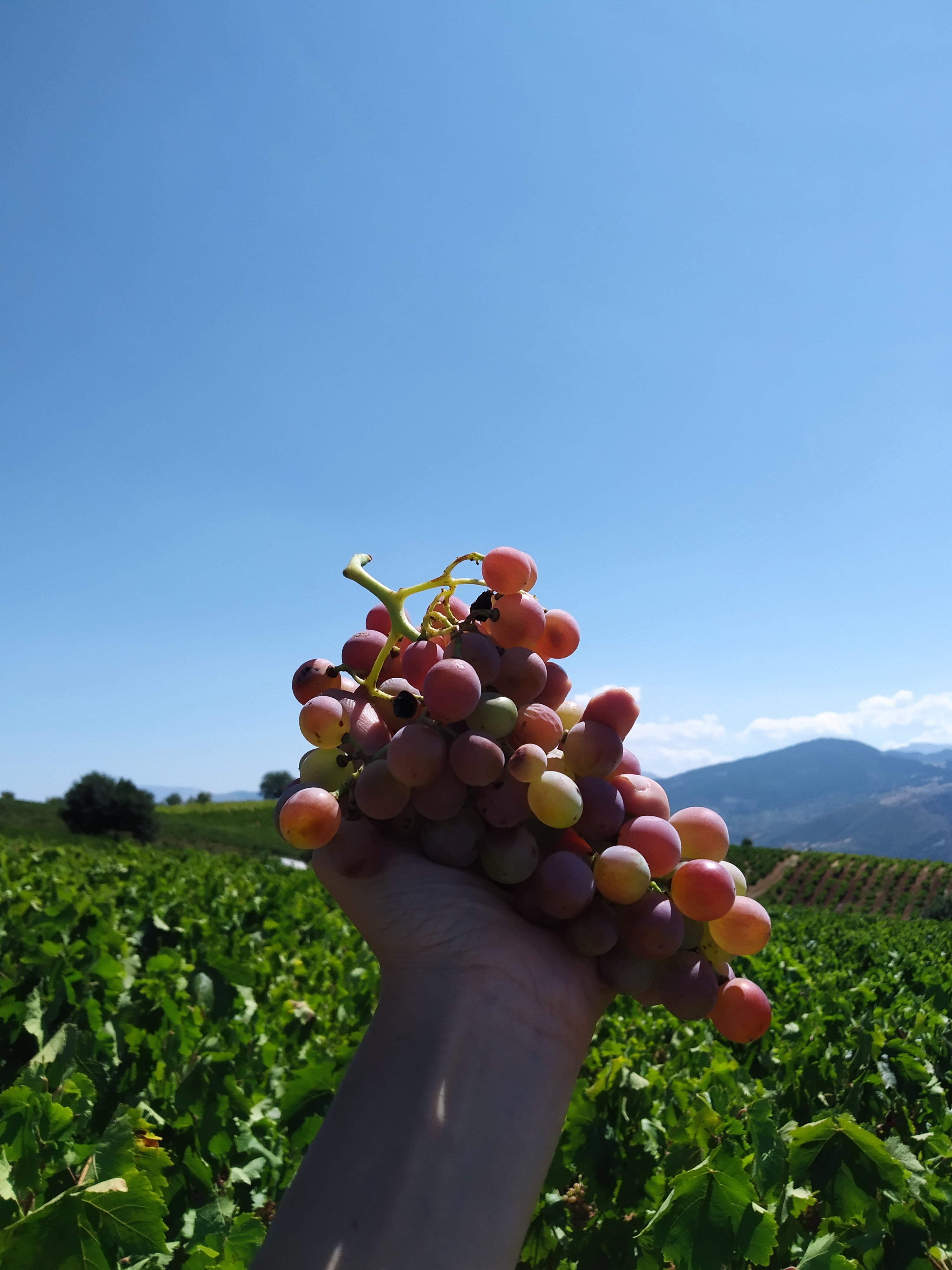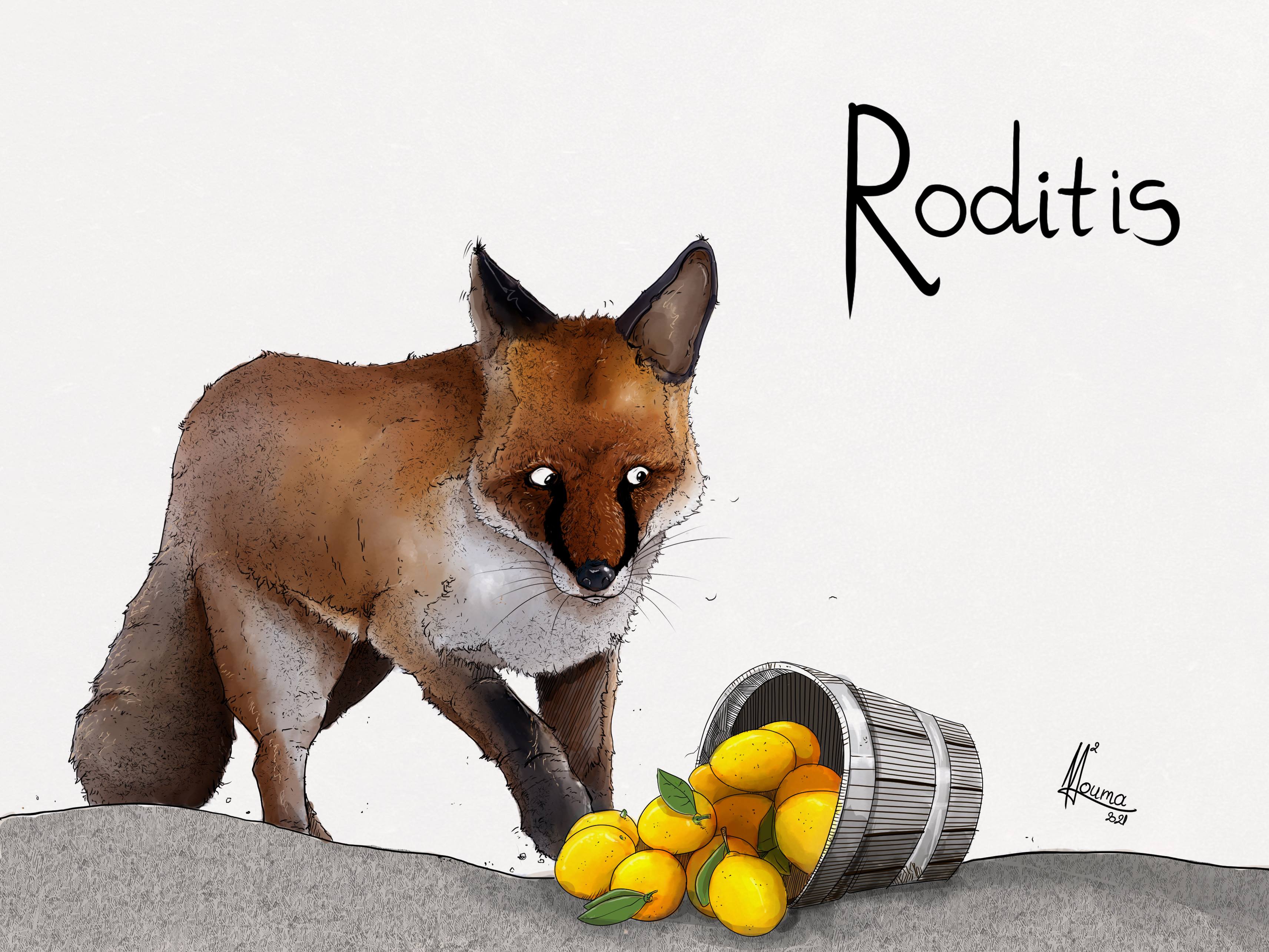
Roditis
At a glance
Roditis is one of the two most planted varieties in Greece. Together with Savatiano, it covers close to one-third of the country’s total plantings. Current numbers show that it is planted in 9150 ha (11% of the Greek vineyard) vs 10.500 of Savatiano (13% of the Greek vineyard), but Roditis is much more productive. It used to be predominantly associated with Retsina, whereas nowadays various clones and mountainous terroirs produce thrilling examples that elevate the variety's excitement. Τo these can add some natural and skin contact versions, as Roditis is a pink-skinned variety.
It is a variety that has been cultivated for very many years all around Greece. Mostly planted in the Peloponnese, in the prefecture of Achaia, Evia, Boeotia, Attica, Thessaly, central and eastern Macedonia.
Roditis (pictured below credit Rouvali winery) produces wines that are light on the aroma scale. Neutral is a common link. However, from high altitudes (up to 1100 m) or when produced from old vines (exceeding 35 years of age) the expression is different; more mineral and with a brightness of fruit that resembles an islandic wine. On the palate, these wines can be steely or fruitier (depending on the site), with a fresh vein of acidity, medium body, and alcohol that rarely exceeds 12.5% abv. They are usually unoaked, but can also be partly oaked, as the different styles are progressively being explored.
This is another example of a variety that proves there are no lesser varieties. Everything depends on how a vine is treated in the vineyard. Initially used in blends, it delivers its ultimate colours on poor, mountainous terroirs.
History
Synonyms: Roiditis, tourkopoula, rodomousi
Αccording to Wine Grapes the name is probably derived from the island of Rhodes, rather than from the colour of the berries (rodon means pink in Greek). Τhe variety was first mentioned as early as the first century in the Greek Anthology by Phillipus of Thessalonica. In the 9th century, Patriarch Photios in Constantinople cited Rodonia as having pink grapes. However, Wines Grapes points out that there is no botanical evidence that these grapes were actually the modern Roditis.
Other sources (Greek Ministry of Agriculture) hold that Roditis is rooted deeply in the past; the name of Roditis is already recorded in Pliny (1st century AD). It seems to have gained great fame during the Venetian period. Later references are found in the 16th century in the Ionian Islands.
Important scientific information from the University of Biology of Milan (Phylogenetic analysis of grapevine cv. Ansonica growing on the island of Giglio, Italy, by AFLP and SSR markers), mentions the genetic affinity of Roditis with the known varieties of Esperia (a comune in the Province of Frosinone in the Italian region Lazio, southeast of Rome) such as Ansonica and Inzolia and the long journey of Roditis from our country to Spain, following the course of the large settlements of the fourth century BC. Besides, the same scientific paper mentions another two relatives, Clairette from France and Airen from Spain.
In the vineyard
As is the case with many Greek varieties DNA evidence is not straightforward. For Roditis, the main reason is its high clonal diversity. More on that on the ampelography section. However, the lack of solid research suggests that Roditis needs to be further researched.
If in the lowlands Roditis gives high yields of more than 150 hl/ha, whereas on the mountain slopes, at 700 m altitude, it excels, producing the most captivating and exciting examples. There the disease and drought resistant, late-ripening Roditis finds an ideal home. With high altitudes and sandy soils, it enjoys ideal conditions for a long vegetative period and slow ripening, creating grapes with outstanding aromatics and high freshness levels.
“The generous yields of Roditis depend on several parameters,” says Panagiotis Papagiannopoulos winemaker at Tetramythos, a visionary on the dynamics of the variety. “A mountainous vineyard, in good productive age, unirrigated, harvested late with low yields for the variety (often above 100 hl/ha) can give lovely fruit and wine that preserves excellent pH and acidity,” he points out.
Roditis is either head-trained or trained in a Cordon Royat system depending on soil type. Prefers deep, rich, cool and loamy soils with CaCo3 are drought-resistant (especially in terroirs with old vines) but are susceptible to downy mildew. Budbreak occurs in late March to early April, flowering in the 2nd 10 days of May, veraison on the 3rd 10 days of July, technological maturity from mid-September to mid-October, depending on the region.
Old vines add layers to the Roditis canvas. Nikos Karatzas, winemaker and owner at Oenops wines, says that he was lucky to find some 50-year-old bush vines in Amyndeo that show a depth of fruit and are great to work with. In Aigialeia, an estimated 30-40% of Roditis exceeds 35 years of age.
Finally, organic farming is a valid part of the discussion. Organic farming is easy to practice as it is an extremely resistant variety to the vine's common diseases. It improves the quality of the grapes produced and slightly reduces the plant's productivity, giving wines of greater concentration.
Ampelography
Large cylindrical-conic, bunches of medium density with a pinkish colour, with a long peduncle lignified to the base. The berry is medium to large-sized, spherical/cylindrical, moderately thick-skinned. The leaf is developed, medium-sized to large, almost wedge-shaped, with three or five lobes. Each bunch weighs around 450 gr.
The variety presents high clonal variability with 8 clones under research. Papagiannopoulos has observed four different biotypes. A feature that complicates the study and detailed description of the variety is that sometimes one finds plants with bunches of three (3) different colours. Also, soil and moisture conditions alter the appearance of the grapes.
According to Papagiannopoulos, the “green Roditis” is the least interesting, whereas the one with a deep purple colour contains excellent tannins and is suitable for extraction and skin contact wine production. “In short, the first post-Phylloxera vines planted in the late 1970s and early 1980s in Aigialeia, Peloponnese, do not include any green Roditis, while the rest coexist”.
There is a big discussion on the superiority of red Roditis called Roditis Alepou translates as Roditis Fox with smaller berries, higher skin to juice ratio, chewy tannins and lower yields.
Terroir
The contrast in the resulting wines from the different terroirs is impressive. As mentioned above the lowlands offer neutral wines with moderate acidity. In contrast, the mountainous terroirs (e.g. Aigialeia, Amyndeo) offer wines with an intense personality, bright acidity and the structure needed for ageing.
In Aigialeia (pictured below)
Theodora Rouvali, owner and winemaker at Rouvalis winery, says that 90% of the viticultural zone of Aigialeia is planted with Roditis. It grows everywhere on the mountains (600-1100m altitude) and in different soil types. Roditis behaves like a chameleon, adapts very well, and expresses its terroir very differently.
From years of observation in the winery, and based on the different microvinifications carried out, she argues that there are different ''crus'' in Aigialeia (second picture below):
- Roditis "Ziria" is an example of the "classic" Roditis, which first became known with the benchmark Asprolithi label in 1990. Intense aromas of melon, fresh green apple and banana and the fullest body.
- Roditis "Koutsoura" (Pyrgaki): It is now an important part of contemporary Asprolithi. Its characteristics are the strong structure, the high acidity, the minerality and the distinctive aroma of flint, that does not emerge as intensely in the other microterroirs.
- Roditis "Trapeza": Lighter and rounder in the mouth and its characteristic is the white fleshy ripe fruit that is sometimes accompanied by tropical notes.
- Roditis "Petsaki": Example of a cooler climate Roditis (more continental microterroir) with characteristic citrus aromas and full flavour.
- Roditis "Myrovrisi": One of the most interesting microterroirs of Aigialeia as it gathers all the geological and climatic advantages of the zone. More elegant and aromatic wines.
Papagiannopoulos adds there is differentiation as followed in the municipality of Diakopto:
- Ano Diakopto: (light, acidic, intense minerality, more lemony)
- Mamousia (opulent, fuller, more tannic)
- Lofos (less alcohol, more malic acid, late-ripening)
- Platanniotissa (extra cool - marginal climate, late-ripening)
The quality superiority of Roditis from the Slopes of Aigialeia is attributed to the fact that a considerable percentage of its two best clones is found in the area:
a) The small-berried Roditis Alepou, early ripening, with an exceptional aroma expressed with a light terpene character at optimal maturity.
b) The "classic" Roditis, which becomes red at veraison, has round medium-sized berries. It is deliciously vibrant with a special aroma.
It is the only region of Greece in which a single varietal PDO appears as Patras PDO.
Achialos and Côtes of Meliton
Part of the blend for these flying under the radar PDO appellations
Other parts of Peloponnese
Roditis is also present in other parts of the Achaia prefecture such as the village of Santameri where producer Panagiotis Dimitropoulos of Santo'r winery cultivates the variety biodynamically in limestone soils at 400 m altitude producing yields of 55hl/ha. He says that Roditis responds very well to this way of vine-growing producing wines with fresh acid and concentration. (typical numbers Ph 3,2 TA 6, 12.55% abv)
Moreover, a classic expression is found in the prefecture of Ilia and more specifically in Mt Foloi, at 550-650 m, where some old vines are found that exceed 40 years of age. Unirrigated and low yielding vines that produce Mercouri Foloi (with 10% Viognier) since 1995.
Macedonia
Amyndeo and Goumenissa. In the former area it is mostly used in blends such as Kir Yianni Paranga with 20% Malagousia, whereas in the latter, the Tatsis winery produces several versions of 100% Roditis.
Periklis Tatsis says that Roditis arrived in the area by Boutari winery in the mid-’70s and following the success of French varieties made a comeback mainly in Retsina wines from the Kechris winery. Yields are extremely low in the Libaskerit (Angels peak) terroir, at 300 m altitude, reaching 35 hl/ha when from old vines. On average, the vines are 25 years old.
Wine Styles
Roditis has no anthocyanins (at least soluble in hydroalcoholic mixtures), therefore skin contact approaches result at most in amber colour. This is the reason for which rosé wines do not exist. The main styles are described below:
Classic fruity: The predominant style of productive Roditis is fruity, medium-bodied with decent acidity.
Mountainous: with lower yields resulting in a more mineral and structured expression
Skin Contact up to 30-40 days which transforms the variety into a structured and ageworthy example.
Notable Producers of 100% Roditis
Rouvali: featuring Asprolithi, the first historical Roditis wine, first produced in 1990.
Tetramythos: producing Roditis and skin contact Roditis matured in oak, alongside Retsina fermented in amphoras. Tetramythos is among the biggest, if not the biggest, supporter of the variety.
Tatsis: Roditis and skin contact Roditis (7-8 m on the lees with no battonage). The classic Roditis was first produced in 1998 while Orange sees maceration of 30 to 46 days and then ages in old oak. The first release of the Orange was in 2011. The 2016 vintage will see 3 years in old oak. Also produces a resin flavoured Roditis.
Mercouri: Foloi Fumé (100% Roditis) matured in second use oak (only in some vintages).
Sant’Or: Classic and Orange, the latter sees fermentation in amphora, 20 days maceration and maturation in a combination of cement eggs and amphoras
Acheon: Roditis and skin contact Roditis
Markogianni: skin contact Roditis
Oenops: Rawditis (fermented and matured in amphora)
Papaioannou: Roditis from Peloponnese
Retsina: Ritinitis Nobilis Gaia, Kechris (Kehribari and Afros), Tetramythos
Ageing Potential
Drink the classic versions in the first 1-3 years and cellar the more complex ones for at least 5-6 years following the harvest.
Challenges Ahead
• Study of the different microterroirs of Aigialeia (to create subzones) and production of different characters of Roditis wines
• The biggest challenge for the region of Aigialeia is to preserve the cultivation of traditional bush vines and to avoid replacing these with the higher-yielding wire-trained option
• Clone work and more emphasis on vineyard management by local growers
• Another challenge is to manage to convince consumers and winemakers that it can stand alone as a variety and does not need to be a part only of blends, as it was in the past, which deprived it of its character and recognition
• In terms of strategic thinking and legislation, perhaps the institution of a PDO Roditis Aigialeia
Perfect Pairing
Roditis is an excellent food partner covering various dishes from fried small fish to vegetable pies with greens and cheese. The skin contact wines pair extremely well with lamb or goat fricassee.
